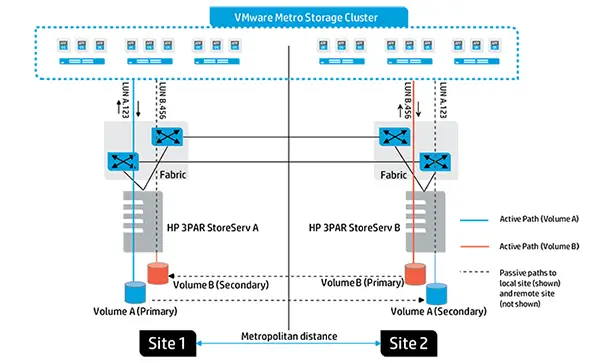VMware Metro Storage Clusters running on top of 3PAR StoreServ storage have gotten an added boost of automation. HP announced 3PAR OS 3.1.2 MU2 during HP Discover two weeks back and one of the features that it introduced is a quorum witness node to assist in Peer Persistence installations. Peer Persistence is the HP 3PAR StoreServ’s version of metro clustered storage for VMware, providing transparent failover of storage from one array to another. With the introduction of the quorum witness, the administrator no longer has to start the failover manually and the witness server adds monitoring and remediation in the event of an outage.
The quorum witness is a separate virtual or physical machine that monitors the availability of both arrays in each site. In most configurations, it should sit in a third site monitoring the two 3PAR arrays. If one of the sites goes down or offline, it detects the status and begins failover on the remaining 3PAR StoreServ array. Because the 3PAR StoreServ uses ALUA to block and open the active IO paths, the failover is seamless to the VMware workloads. All of this is accomplished by using the same virtual volume world wide name on both arrays and by blocking IO to the secondary copy.

Source: HP
During HP Discover, I was able to talk with several HP engineers about the new feature and one of my initial concerns was whether this is an all or nothing configuration for automated failover. Fellow blogger, Justin Vashisht, confirmed that each virtual volume or group of virtual volumes can be controlled automatically or manually – the administrator has the choice when configuring the volumes.
When we purchased our 3PAR StoreServ arrays earlier this year, our sales team confirmed that the automated failover would be forthcoming and so, as a customer, this is a feature we are happy to see delivered quickly. One of the unknowns to us was how HP would architect the quorum witness, but in talking with Siamak Nazari, an HP Fellow and chief software architect of HP Storage division, HP adapted the 3PAR Storage Processors to also do the duty of quorum witness. This means the new feature is based upon what should be solid and field-tested code.
Nazari and David Scott, HP Storage Senior Vice President and General Manager, stopped by the bloggers area at HP Discover for a coffeetalk with a large group of us. One of the things that I found most interesting from the talk is that HP has somewhat future-proofed the 3PAR StoreServ arrays it is already shipping – by baking in additional capabilities into the ASIC and by activating those with software at later time. That leaves hope that there will be other new capabilities introduced for existing customers, although nothing specific was revealed to us.
When I first discussed the Peer Persistence feature on my blog earlier this year, I praised the simplicity of the solution both from an architectural and administrative standpoint. While advancing the features in the new release, I think that HP has also made a wise choice to keep things simple even with the quorum witness added to the mix. As an administrator, I appreciate the straight forward and easy to understand (and troubleshoot) approach of the solution.
Another welcome feature for GUI fans, HP has introduced control of Peer Persistence under the Remote Copy tools within the 3PAR Management Console GUI. This means that administrators now have the choice of configuring and initiating failover from within the GUI, though I think I still prefer the single command-line command.
And as of the time of writing, HP reports that 3PAR Peer Persistence is VMware Metro Storage Clustering certified, although I do not see it in the VMware compatibility matrix yet. Lots of great incremental improvements to the 3PAR StoreServ line with this new OS revision.
Disclosure: HP sponsored my trip to HP Discover, covering all travel expenses, however HP does not control the content of the posts that I write based on my attendance to the show. The thoughts, impressions and information contained in this post are my own.
